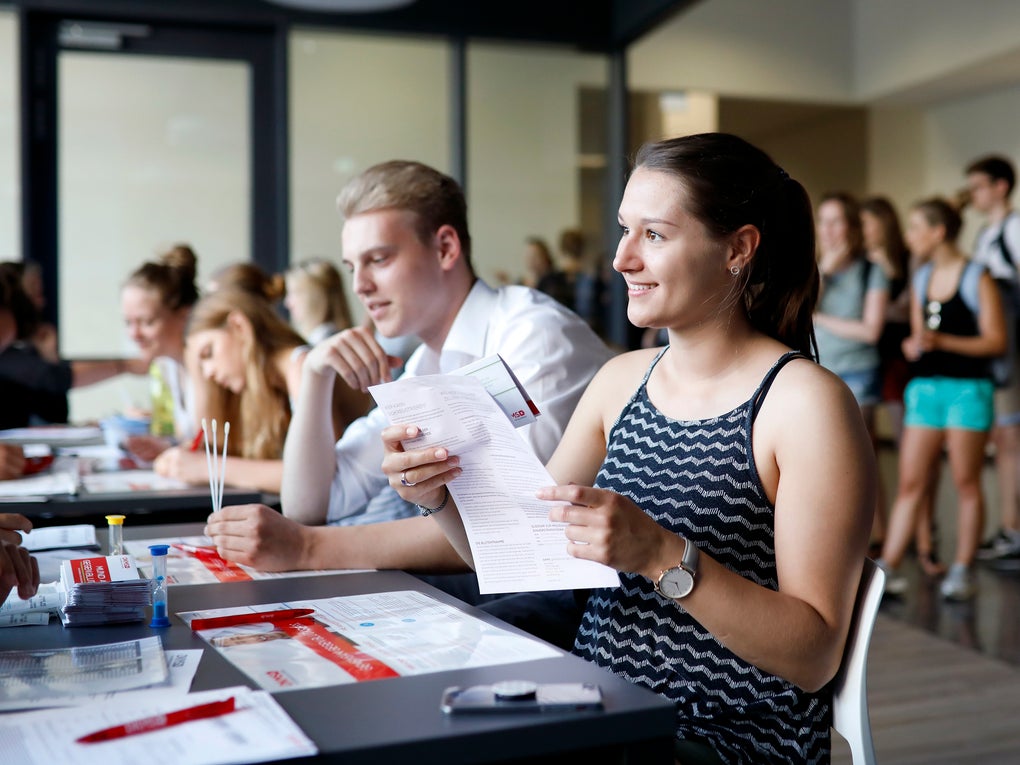
Rette Leben - Jetzt registrieren!
Deine Registrierung schenkt Betroffenen weltweit Hoffnung! Worauf wartest du noch?

Wie funktioniert’s?
Häufig gestellte Fragen
Grundsätzlich kann sich jeder gesunde Mensch im Alter zwischen 17 und 55 Jahren als potenzielle:r Stammzellspender:in registrieren. 17-Jährige dürfen zwar noch keine Stammzellen spenden, werden aber ab dem 18. Geburtstag automatisch in unserer Datei aktiviert und bei der Suche nach Spendern berücksichtigt.
Falls du bereits bei uns oder in einer anderen Datei erfasst bist, ist eine erneute Aufnahme nicht erforderlich. Solltest du unter einer chronischen oder einer anderen schweren Erkrankung leiden oder gelitten haben oder regelmäßig Medikamente einnehmen, halte bitte unter medizinische-spenderanfragen@dkms.de Rücksprache mit der DKMS.
Registriere dich bitte NICHT, wenn du AKTUELL von einem der folgenden Kriterien betroffen bist:
- Starkes Übergewicht, d.� h. Body-Mass-Index (BMI) >40 (BMI = Gewicht / Körpergröße zum Quadrat)
- Starkes Untergewicht, d. h. Body-Mass-Index (BMI) <16,5
- Schwere Herz-Kreislauf-Erkrankung
- Schwere Lungenerkrankung
- Schwere Nierenerkrankung
- Schwere neurologische oder psychische Erkrankung
- Schwere Stoffwechselstörung
- Tropenkrankheiten und schwere chronische Infektionskrankheiten
- Infektion mit HIV, Hepatitis B oder C
- Systemische Autoimmunerkrankung oder andere schwere chronische Erkrankung (z.B. Diabetes, Rheuma)
- Krebserkrankung (auch ausgeheilte in der Vorgeschichte)
- Schwere Krankheiten des Bluts oder des Immunsystems
- Suchterkrankungen (Alkohol, Drogen, Medikamente)
Die Registrierung ist ohne Rücksprache möglich, wenn die folgenden Kriterien auf dich zutreffen:
- Vergrößerte Schilddrüse/Unterfunktion der Schilddrüse/Hashimoto-Thyreoiditis (stabil und beschwerdefrei; auch mit Einnahme von Schilddrüsenhormonen oder Jodid; kein Morbus Basedow)
- Bluthochdruck (stabil und gut eingestellt)
- Heuschnupfen, leichtes Asthma (ohne Anfälle), Nahrungsmittelallergie
- Unipolare Depressionen (ohne Einschränkungen im Alltag)
- Eisenmangelanämie (gut mit Eisentabletten behandelbar)
- Basaliome und Gebärmutterhalskrebs in situ (nach vollständiger Entfernung)
Die Registrierung als Stammzellspender bei der DKMS ist ausschließlich für Personen mit festem Wohnsitz in Deutschland möglich. Potenzielle Spender mit Wohnsitz im Ausland können sich bei ihren jeweiligen nationalen Stammzellspenderregistern registrieren und stehen damit dem weltweiten Suchlauf zur Verfügung. Eine Liste der nationalen Register findest du unter: https://share.wmda.info/display/WMDAREG/Database#
Eine Registrierung als Stammzellspender:in ist eine freiwillige Leistung. Ebenso freiwillig ist es für jede:n neue:n Spender:in, die Kosten von 50 Euro für die Registrierung selbst zu übernehmen. Viele unserer Spender:innen tun dies bereits, und wir sind ihnen dafür sehr dankbar. Wir können und wollen niemanden zur Kostenübernahme verpflichten, sondern appellieren an die allgemeine Spendenbereitschaft, um unsere Datei weiter ausbauen und optimieren zu können. Grundsätzlich gilt: Wir freuen uns über jede freiwillige Spende! Denn jeder Euro hilft uns, noch mehr zweite Lebenschancen zu ermöglichen.
Es gibt zwei verschiedene Methoden, Stammzellen zu spenden: die periphere Stammzellentnahme und die Knochenmarkentnahme.
Periphere Stammzellentnahme
Die periphere Stammzellentnahme kommt derzeit mit circa 90 Prozent am häufigsten zum Einsatz. Bei dieser Methode werden die Stammzellen über ein spezielles Verfahren (Apherese) aus dem Blut gewonnen. Die Ärztin oder der Arzt legt dazu jeweils einen Zugang in beide Armvenen, ähnlich einer Dialyse. Zuvor erhalten alle Spender:innen über fünf Tage hinweg ein Medikament mit dem Wachstumsfaktor G-CSF. Der hormonähnliche, körpereigene Stoff G-CSF sorgt für eine vermehrte Produktion von Stammzellen und deren Ausschwemmung in die Blutbahn. Die periphere Stammzellentnahme dauert normalerweise drei bis höchstens fünf Stunden. In der Regel können unsere Spender:innen die Entnahmeklinik noch am selben Tag verlassen. Nur sehr selten wird ein zweiter ambulanter Entnahmetag notwendig.
Knochenmarkentnahme
Die Knochenmarkentnahme kommt bei etwa 10 Prozent der Stammzellspenden zum Einsatz. Bei der Knochenmarkentnahme wird den Spender:innen in einer zertifizierten Entnahmeklinik unter Vollnarkose circa ein Liter Knochenmark-Blut-Gemisch aus dem Beckenkamm entnommen. Das sind etwa fünf Prozent des Gesamtknochenmarks. Das Knochenmark regeneriert sich innerhalb weniger Wochen. Im Anschluss an die Knochenmarkentnahme ist es möglich, dass für wenige Tage ein lokaler Wundschmerz auftritt, ähnlich dem bei einer Prellung. Zur Knochenmarkentnahme bleiben unsere Spender:innen normalerweise für ein bis zwei Nächte im Krankenhaus. Anschließend raten unsere Ärzt:innen dazu, sich nach Rücksprache mit der Entnahmeklinik noch einige wenige Tage zu Hause zu erholen. Das gesundheitliche Risiko der Knochenmarkentnahme ist gering. Es beschränkt sich im Wesentlichen auf das allgemeine Risiko, das mit jeder Operation unter Vollnarkose einhergeht. Um vermeidbare Risiken auszuschließen, hat für uns die sorgfältige medizinische Voruntersuchung unserer Spenderinnen und Spender höchste Priorität.